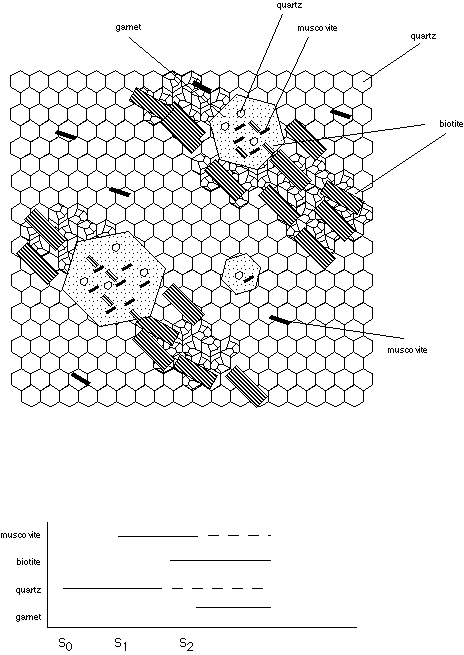
Lab 4B-Porphyroblasts & Shear Zones
3) Complex porphyroblast/matrix relationships
RJ90410, from near Kiewa, eastern Victoria. Quartz-muscovite-biotite schist, with andalusite porphyroblasts containing abundant graphite-rich inclusion trails: hunt around for the biggest andalusite- it will show the best inclusion trails.

RJS90436. This is a quartz-muscovite-biotite-sillimanite schist, with minor zircons. The main fabric of the rock is made up of an anastomosing foliation cut by shear bands, which on the large scale show a fairly consistent asymmetry. The zircons cannot be identified directly, however the dark radiation damage haloes in the biotites are characteristic of this Uranium rich mineral.

RLA-1A Quartz-muscovite-biotite-chlorite-garnet schist. This thin section is a higher grade example of the crenulations you saw in the Lake Glenmaggie slide, and preserves evidence of several stages of deformation in the porphyroblast inclusion trails. The overview picture taken with cross polars is about 1.5 across, and the enlargement shows the large grain in the lower right of the image in plain and cross polarised light.



Example Timing Chart

4) Shear zones and kinematic indicators in naturally deformed rocks.
S-C Mylonite. This rock is a superb example of a type II S-C mylonite. C-planes are defined by thin mica-rich seams, with occasional mica "fish" which have been sheared to produce asymmetric shapes that indicate the sense of shear, which matches the sense of shear indicated by the S-planes defined by the quartz grain shape preferred orientation. Note that the dynamic recrystallisation has reached an equilibrium with the straining such that the preferred orientation of grain shapes does not in any way reflect the finite strain. Put the gypsum plate in to see the very strong but domainal preferred orientation of lattice planes in the quartz.
257 Quartz-muscovite-biotite-graphite-garnet schist. This thin section shows a number of beautiful metamorphic and deformation microstructures, including pressure shadows around porphyroblasts (rare at these temperatures), zoned inclusions, inclusion trails. The first image shows an overview and the subsequent images show enlargements from the same slide.

 |
 |
 |